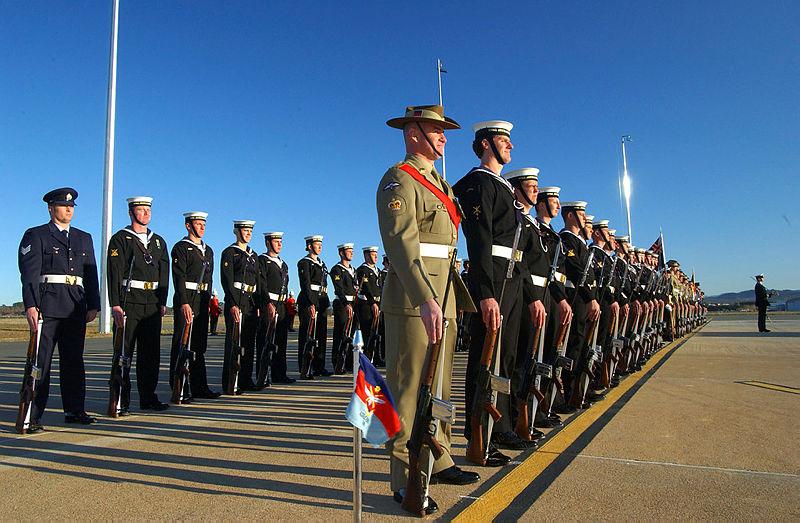A wide brown land needs a big, big defence policy and Australia has received that very thing with this morning’s delivery of the 2016 Defence White Paper.
Conceived in 2013, gestating like a humongous pearl in 2014 and 2015, the 2016 White Paper largely lives up to its self-made claim to be ‘deliberate, rigorous and methodical’. Although a close read occasionally points to the White Paper’s mixed parentage—the words ‘agile’ and ‘innovative’ are salted through the text—this is a document that sets out a clear strategy, a logically-articulated force structure and—can you believe it—a plausible funding plan.
The strategy all hinges on the money. To the extent that any government can commit their heirs and successors, this White Paper locks in a promise to reach a defence budget ‘just ahead’ of 2% of gross domestic product in 2020–21. That’s three years in advance of Tony Abbott’s pledge to reach 2% of GDP in 2023–24. Some decry the value of the 2% target, but it kept both Government and Opposition focused on security at a time when others would have happily ditched the spending promise.
On strategic outlook, the White Paper makes a compelling case for being concerned about a generally deteriorating situation. It does so after a throat-clearing reference to the ‘greater opportunities for prosperity and development’ afforded by generally exciting times. But opportunities for positive excitement can only be realised if prosperity stays underpinned by peace and stability.
The risks are elaborated: cyber attacks are ‘a real and present threat’; there will be ‘greater uncertainty’ for at least the next two decades; serious ‘points of friction’ are emerging between China and the US; Russia emerges increasingly ‘coercive and aggressive’; terrorism is growing and regional countries aren’t well placed to handle it; the South China Sea ‘will continue to provide a source of tension that could undermine stability’; and so on.
The list of risks isn’t exaggerated and they cumulatively point to the need for a stronger set of military capabilities and an Australian Defence Force more engaged in Indo–Pacific regional security cooperation. (Upcoming posts on The Strategist will look in detail at capability choices.)
Here it’s worth noting that the 2016 White Paper makes more of Defence ‘posture’ than any of its predecessors. ‘Posture’ in this sense means what you do with the Defence Force you already have. That’s the real start of planning for the defence force we would like to have and might get if funding assumptions hold.
Three ‘Strategic Defence Interests’ are said to shape policy decisions. These are: one, having the capacity to deter or defeat any attack on, or attempt to coerce, Australia. Two, securing our nearer region of ‘maritime Southeast Asia’ and the Pacific; and three, contributing to a stable Indo–Pacific region and a rules-based global order.
Fundamentally it’s the second of those priorities that drives key posture and future force structure decision-making. The White Paper can be seen as the concluding verse to the generation-long saga of the Defence of Australia (DOA) strategy. ‘DOA’ is now fully effected in a maritime strategy focused on Southeast Asia and the Pacific.
Defence’s international engagement effort is projected to grow renewed priority for bilateral and multilateral cooperation. ADF readiness levels are to be raised to allow for a more sustained ADF presence in the region—a potentially expensive decision. The numbers of ADF and Defence civilian personnel posted overseas will increase, but there are few details about how that will be done.
Almost every major relationship in the Indo–Pacific is projected to grow. The document is bullish on prospects for cooperation with Indonesia. Areas identified for more cooperation include counterterrorism, maritime engagement, HADR, peacekeeping and intelligence. Interestingly, the White Paper refers to the modernisation of the Indonesian Armed Forces as a ‘positive development’ in regional security and anticipates that Australia could support that process.
The paragraphs on Japan show how far the bilateral relationship has come even before any final decision is made on the preferred submarine design. Identified areas for cooperation include intelligence, developing common capabilities like the Joint Strike Fighter, air and missile defence and maritime warfare technologies. It’s perhaps not unconnected with a statement in the section on missile defence which says that Australia will participate in a bilateral working group with the US to examine ‘options for potential Australian contributions to integrated air and missile defence in the region’.
On China, the White Paper is measured and restrained. It talks rather soberly of the ‘productive working relationship’ on Defence matters and stresses in several places that China has an opportunity to step forward to play its own role in regional peace and stability in ‘North Asia and the Indo–Pacific.’
The Paper is concerned about the South China Sea becoming a source of tension that could undermine stability. It pointedly says that ‘Australia is particularly concerned by the unprecedented pace and scale of China’s land reclamation activities’. It pronounces that countries should be ‘open and transparent about end-state purposes of land reclamation activities’. Well, a White Paper would have to say something like that, wouldn’t it? The ‘end state purposes’ of China’s activities in the South China Sea are pretty obvious, even to the half-blind dugongs that might once have swum around Mischief Reef.
Although Tony Abbott’s rhetorical flourish of the ‘long, strong arm’ of the ADF is behind us, the White Paper preserves a welcome commitment to thinking about Australian strategic interests on a global canvas. Apart from the US, New Zealand and the Pacific, the section on engagement also highlights Australia’s productive defence links with the UK, NATO, the UN, France, Canada, the Netherlands, Spain and Germany. This is a welcome change and points to a growing maturity around the thought that Australia can do the strategic equivalent of walking and chewing gum. When it comes to defence thinking we can be both global and local—a skill demanded of us by our increasingly risky strategic environment.
